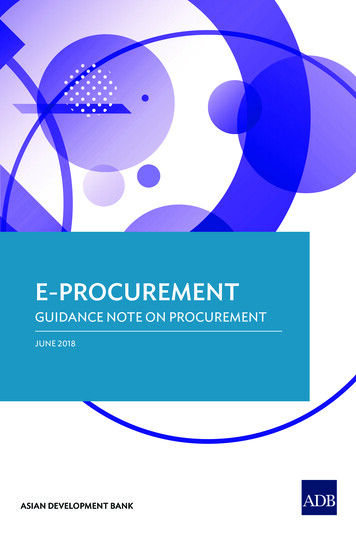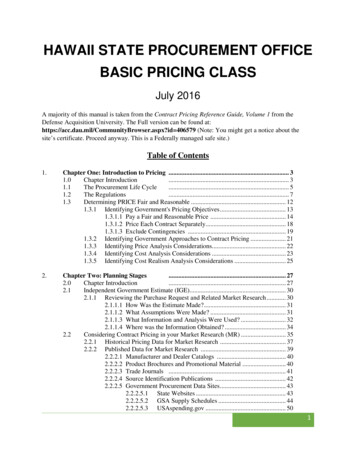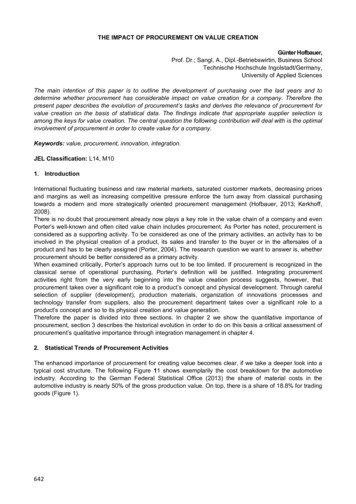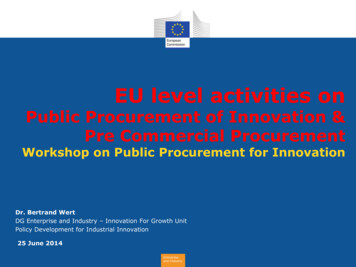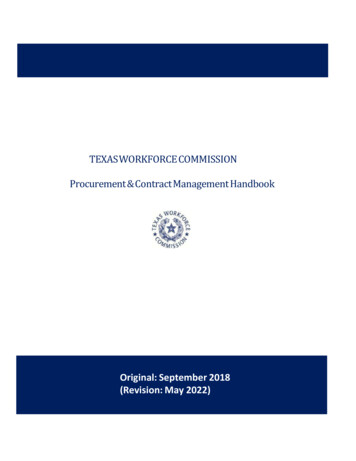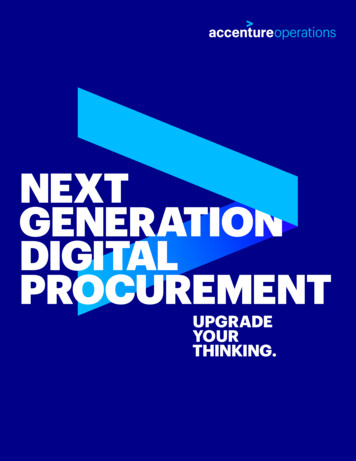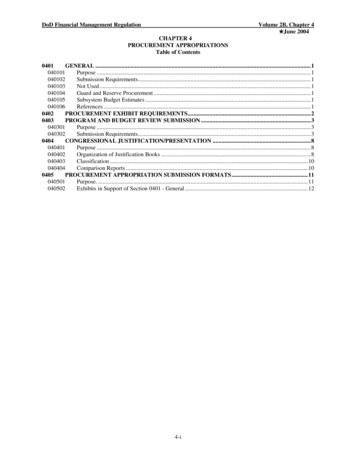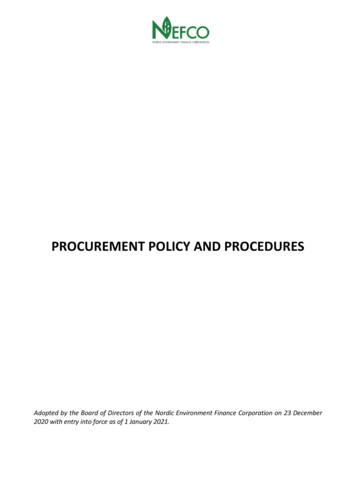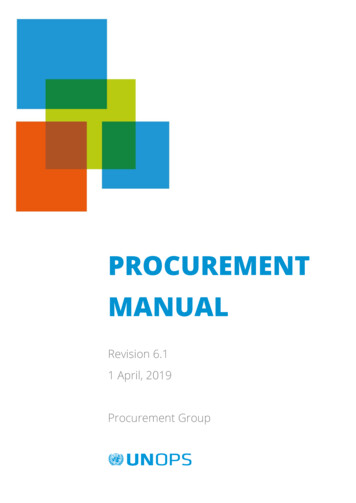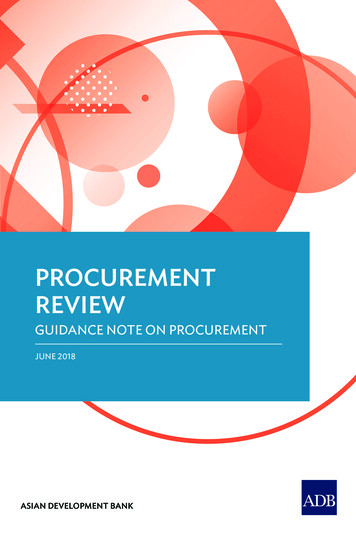
Transcription
PROCUREMENTREVIEWGUIDANCE NOTE ON PROCUREMENTJUNE 2018ASIAN DEVELOPMENT BANK
PROCUREMENTREVIEWGUIDANCE NOTE ON PROCUREMENTJUNE 2018ASIAN DEVELOPMENT BANK
Creative Commons Attribution-NonCommercial-NoDerivs 3.0IGO license (CC BY-NC-ND 3.0 IGO) 2018 Asian Development Bank6 ADB Avenue, Mandaluyong City, 1550 Metro Manila, PhilippinesTel 63 2 632 4444; Fax 63 2 636 2444www.adb.orgSome rights reserved. Published in 2018.ISBN 978-92-9261-220-7 (print), 978-92-9261-221-4 (electronic)Publication Stock No. TIM189414-2DOI: http://dx.doi.org/10.22617/TIM189414-2The views expressed in this publication are those of the authors and do not necessarily reflectthe views and policies of the Asian Development Bank (ADB) or its Board of Governors orthe governments they represent.ADB does not guarantee the accuracy of the data included in this publication and accepts noresponsibility for any consequence of their use. The mention of specific companies or productsof manufacturers does not imply that they are endorsed or recommended by ADB in preferenceto others of a similar nature that are not mentioned.By making any designation of or reference to a particular territory or geographic area, or by usingthe term “country” in this document, ADB does not intend to make any judgments as to the legalor other status of any territory or area.This work is available under the Creative Commons Attribution-NonCommercial-NoDerivs 3.0IGO license (CC BY-NC-ND 3.0 IGO) go/.By using the content of this publication, you agree to be bound by the terms of this license.For attribution and permissions, please read the provisions and terms of use athttps://www.adb.org/terms-use#openaccess.This CC license does not apply to non-ADB copyright materials in this publication. If the materialis attributed to another source, please contact the copyright owner or publisher of that sourcefor permission to reproduce it. ADB cannot be held liable for any claims that arise as a resultof your use of the material.Please contact pubsmarketing@adb.org if you have questions or comments with respect tocontent, or if you wish to obtain copyright permission for your intended use that does not fallwithin these terms, or for permission to use the ADB logo.Notes:In this publication, “ ” refers to United States dollars.Corrigenda to ADB publications may be found at http://www.adb.org/publications/corrigenda.Printed on recycled paper
ContentsTable, Figures, and Box ivAbout This Publication vAbbreviations viiiExecutive Summary ixI.Introduction 1II.Prior Review 3III. Post Review (Sampling) 6IV. Contract Review and Sampling Methodology 8Appendix: Templates for Post Review (Sampling) 13
ivTable, Figures, and BoxTableRisk Rating Descriptions for ADB’s Post Review (Sampling) Report 12FIGURES1.The ADB Procurement Cycle 22.Indicative Sample Size for Post Review 9BOXVariables to Consider When Creating Groups of Similar Contracts for Post Review (Sampling)9
vAbout This PublicationIn April 2017, the Asian Development Bank (ADB) approved its new procurementframework, the ADB Procurement Policy: Goods, Works, Nonconsulting andConsulting Services (2017, as amended from time to time); and the ProcurementRegulations for ADB Borrowers: Goods, Works, Nonconsulting and ConsultingServices (2017, as amended from time to time). These replace the former Guidelineson the Use of Consultants (2013, as amended from time to time) and ProcurementGuidelines (2015, as amended from time to time). The procurement policy and theprocurement regulations address the procurement activities of project executingagencies and implementing agencies on projects financed in whole or in part by aloan or grant from ADB, or by ADB-administered funds. ADB designed the 2017procurement policy to deliver significant benefits and flexibility throughout theproject procurement cycle, as well as to improve project delivery through a renewedfocus on the concepts of quality, value for money (VFM), and fitness for purpose.This note is part of a series of guidance notes published by ADB in 2018 toaccompany the 2017 procurement policy and the procurement regulations.Each note discusses a topical issue for borrowers (including grant recipients),bidders, and civil society under the new framework (see list below). The guidancenotes cross-reference each other frequently and should be read in conjunction.All references to “guidance notes” pertain to these notes. The notes may beupdated, replaced, or withdrawn from time to time.List of Guidance Notes for the 2017 ADB ProcurementPolicy and the Procurement Regulations1.2.3.4.5.6.7.8.9.10.11.12.Value for MoneyProcurement Risk FrameworkStrategic Procurement PlanningProcurement ReviewAlternative Procurement ArrangementsOpen Competitive BiddingPrice AdjustmentAbnormally Low BidsDomestic PreferencePrequalificationSubcontractingConsulting Services Administeredby ADB Borrowers13. Nonconsulting Services Administeredby ADB Borrowers14. High-Level Technology15. Quality16. Bidding-Related Complaints17. Noncompliance in Procurement18. Standstill Period19. State-Owned Enterprises20. E-Procurement21. Framework Agreements forConsulting Services22. Public–Private Partnerships23. Contract Management24. Fragile, Conflict-Affected,and Emergency Situations
viAbout This PublicationADB procurement reforms intend to ensure VFM by improving flexibility, quality,and efficiency throughout the procurement cycle (see illustration below and theGuidance Note on Value for Money). VFM is part of a holistic procurement structurewith three support pillars: efficiency, quality, and flexibility. The two key principles oftransparency and fairness weave across all elements of the structure.Tra n s p a re n c yValue for MoneyThe effective, efficient, and economic use of resources,which requires an evaluation of relevant costs and benefits alongwith an assessment of risks, nonprice attributes, and/or total costof ownership as appropriateEfficiencyQualityFlexibility Decreased transactioncosts Increased skills Increased high-leveltechnology usage Improvedprocurement planning Support andencouragementof e-procurementsystems Contract managementsupport Prompt resolution ofcomplaints Improved developingmember countryprocurement process Improvedprocurement planning Governance Contracts with clearperformance criteria Minimal number ofcomplaints Improved ADBprocesses Open competitivebidding Decentralization Accreditationfor alternativeprocurementarrangements Principles-baseddecisions Improvedprocurement planning Delegation Bids with weightedproposalcriteriaFairnessTimeTime is an important element of VFM. When a project is delivered promptly or when aprocess is completed rapidly, greater value is created for all stakeholders. For example, aroad project completed early provides economic benefit, security, or other value to thecommunity it serves. It increases the return on investment to the executing agency andaccelerates the project and payment cycle to the successful bidder. Likewise, a projectdelivered late loses significant value.When considering VFM in the context of procurement, pay attention to anythingthat (i) shortens the procurement cycle time frame or (ii) accelerates delivery of thedevelopment project.
About This PublicationObjectiveThis guidance note is intended to assist readers by elaborating on and explainingADB’s 2017 procurement policy and procurement regulations for borrowers(including grant recipients).This note identifies additional information for the reader to consider when applying ADB’sprocurement policy and procurement regulations to their circumstances.Living DocumentThis guidance note is intended to be a living document and will be revised as required.Be sure to check the ADB Business Center website for the latest version and updates,https://www.adb.org/business/main.The ReaderIn many circumstances, readers are expected to use this guidance note in a manner uniqueto their needs. For consistency throughout the suite of guidance notes, the followingassumption is made about the reader:The reader is a professional involved in activities financed in whole or in part by an ADB loanor grant, or by ADB-administered funds.FAQsFrequently asked questions, clarifications, examples, additional information, links to training,and other useful resources will be made available on the ADB website.Be sure to check the ADB Business Center website for more l and Order of PriorityThis guidance note explains and elaborates on the provisions of the ProcurementRegulations for ADB Borrowers: Goods, Works, Nonconsulting and Consulting Services(2017, as amended from time to time) applicable to executing (and implementing) agenciesunder sovereign (including subsovereign) projects financed in whole or in part by aninvestment loan from ADB (i.e., excluding ADB results- or policy-based loans),ADB-financed grant (excluding ADB-administered technical assistance and staffconsultancies), or by ADB-administered funds.In the event of any discrepancy between this guidance note and the procurementregulations, the latter will prevail. The financing agreement governs the legal relationshipsbetween the borrower and ADB. The rights and obligations between the borrower and theprovider of goods, works, or services are governed by the specific procurement documentissued by the borrower and by the contract signed between the borrower and the provider,and not by this guidance note.vii
viiiAbbreviationsADB—Asian Development BankIFB—invitation for bidsRFP—request for proposalsVFM—value for money
ixExecutive SummaryThis guidance note provides information on the ADB process for reviewing aborrower’s (or grant recipient’s) procurement processes under projects financed inwhole or in part by a loan or grant from ADB, or by ADB-administered funds. Thisreview aims to ensure that the borrower’s procurement processes comply with theterms of ADB’s 2017 procurement regulations and those of the project’s financingagreement, procurement plan, and relevant procurement documents.This guidance note describes the two methods of ADB’s procurement review: priorreview and post review (sampling). The note discusses the method for determiningthe most appropriate type of review applicable to specific contracts under aproject based on the project procurement risk rating and on contract values andcomplexity, and highlights other factors to consider in performing each type ofreview.An effective procurement review mayIncrease Efficiency and Reduce Procurement Time A risk-based approach in determining the type of procurement reviewimproves efficiency by applying a fit-for-purpose review methodology.Appropriate use of post review (sampling) reduces procurement timesby removing the need for ADB’s prior review of each main step in theprocurement process.Procurement reviews avert additional delays that may result from inadequateidentification and handling of procurement risks and noncompliance.Reduce Risk Procurement reviews identify risks and deficiencies in the borrower’sprocurement processes and recommend ways to mitigate them, therebyreducing risk of future noncompliance or project failure.Reduce the risk of bidding-related complaints.Improve compliance to audit requirements (both national and ADB).Deliver Value for Money Procurement reviews decrease the risk of noncompliant practices that mayadversely affect the project’s achievement of value for money.
I. Introduction1.1Procurement reviews are conducted by the Asian Development Bank(ADB) to ensure that funds for projects financed in whole or in part by a loan orgrant from ADB, or by ADB-administered funds, are used for purposes for whichthey were granted. Procurement reviews also work to ensure that procurementis conducted in accordance with the ADB Procurement Policy: Goods, Works,Nonconsulting and Consulting Services (2017, as amended from time to time) andthe Procurement Regulations for ADB Borrowers: Goods, Works, Nonconsultingand Consulting Services (2017, as amended from time to time). Procurementreviews are conducted in one of two ways: (i) prior review, in which ADB reviewsand approves key documents and decisions prior to them being implemented;or (ii) post review (sampling), in which ADB reviews documents, decisions, andprocurement processes, on a sample basis, after contract signing.11.2Determining whether a procurement process is subject to prior or postreview (sampling) is based on the project risk categorization, which is initiallyconducted at the project conceptualization stage and validated at the procurementplanning stage of the ADB procurement cycle (Figure 1), considering plannedprocurement packages and specific project procurement risks. For more details,refer to the Guidance Note on Procurement Risk Framework and the Guidance Note onStrategic Procurement Planning.1.3The agreed review arrangement for each contract is indicated in theprocurement plan. During procurement planning, if the validation of the projectcategorization results in a change in risk category, ADB may require the borrower(or grant recipient) to revise the prior or post review (sampling) requirements inthe procurement plan. ADB and the borrower implement the agreed procurementreview arrangements from the bidding stage (including advertising andprequalification, where used) through to the contract closure stage of the ADBprocurement cycle (Figure 1).1.4This guidance note intends to assist users with the selection andapplication of the two types of procurement review: prior review and post review(sampling). The activities relating to procurement review commence at theplanning stage with the aim of ensuring that procurement processes comply withthe agreed principles and procedures and deliver value for money.1If the use of alternative procurement arrangements has been permitted under a particularproject, a trust-and-verify procurement oversight approach will be applied, whereby ADB maynot exercise prior or post review (sampling), but may rely on oversight mechanisms of theborrower or those agreed in the applicable financing or other agreements.
2Procurement ReviewFigure 1: The ADB Procurement CycleCountry PartnershipStrategyCountry and Sector/AgencyProcurement Risk AssessmentFeedback or EvaluationProject ConceptualizationProject Completion ReportContract CloseLessons LearnedEfficiencyPROCUREMENTCYCLEM alu eo n fo reyneProcurement PlanningProcurement PlanProject Procurement RiskAssessmentProject Administration ManualssVContract AwardsparencyTranContract Management PlanEconomyImplementation andContract ManagementlityuaQTransaction Technical AssistanceProcurement Risk CategorizationFa i rBiddingBidding DocumentsBid EvaluationEvaluation ReportsProcurement Review(Implementation)Source: Asian Development Bank.Procurement Review(Planning)
II. Prior Review2.1Prior review is conducted on contracts categorized as high risk duringthe project conceptualization stage, and as validated and specified in the projectprocurement plan (as endorsed by ADB) in conformity with the project’s legal andfinancial agreements.2.2Prior review involves ADB reviewing and providing a “no-objection”prior to each step in the procurement process, to confirm that the borrower’sproposed procurement actions comply with ADB’s 2017 procurement policy andprocurement regulations; and the project’s financing agreement, procurementplan, and, where applicable, the provisions of the relevant procurement documents(collectively referred to as “the agreed procurement procedures”). Prior reviewincludes reviews of the borrower’s procurement procedures, documents, bidevaluations, award recommendations, and draft contracts.2 The borrower shallsatisfactorily address ADB’s comments, including making requested modificationsto the reviewed documents.2.3Appendix 6 of the 2017 procurement regulations details the ADBprior review procedures applicable to open competitive bidding. The generalrequirements for prior review at key stages are as described in the followingsubsections.A.Prequalification (Shortlisting) Stage2.4Prequalification (shortlisting) is generally used for consulting services andoccasionally for procurement of works and plant. Where prequalification is used,ADB reviews the following documents:(i) the text of the invitation to prequalify or request for expressions ofinterest,3(ii) the prequalification documents or terms of reference,(iii) the evaluation methodology or shortlisting criteria, and(iv) a description of the advertising procedures to be followed.23For consulting selections by the borrower, the prior review process is generally compiled into“submissions.” The number of submissions may vary from one to three, depending on theselection method, and will be agreed on in the procurement plan.Prior review of this document is not usually requested for the borrower’s consulting selections.
4Procurement Review2.5The borrower must furnish the prequalification evaluation report and thelist of prequalified or shortlisted applicants or consultants to ADB for its commentsand no-objection before the applicants or consultants are notified of the borrower’sdecision.B.Prior to Issuing the Procurement Documents2.6The documents for review include(i) the draft invitation for bids4 and/or the letter of invitation toconsultants; and(ii) the draft bidding documents and/or the draft request for proposals(RFP), including the draft contract.2.7The first draft bidding documents and draft invitation for bids (IFB)5 foreach type of contract for goods, works, nonconsulting services, and consultingservices, regardless of value, shall be prior reviewed before the publication ofthe IFB and issuance of bidding documents. For subsequent, low-risk contractsof similar type, the borrower may proceed with publishing the IFB and issuingthe bidding documents to bidders, together with submitting the same to ADBfor parallel review, so that any deficiencies in the bidding documents could becorrected through addenda before the bid submission date. However, suchapproach is applicable to borrowers that have demonstrated adequate capacity andthat are willing to proceed with issuance of the bidding documents at their own risk.C.After Receipt of Bids or Proposals2.8The documents for review include(i) the bidding documents and/or the draft RFP as issued and (whererelevant) as amended, including copies of questions received (if any)and answers given;(ii) the technical evaluation report, where technical evaluation has takenplace separately from financial evaluation, (most commonly used forselection of consulting services and the procurement of goods, works, andnonconsulting services under two-stage or two-envelope procedures);(iii) the revised technical evaluation report and financial evaluationreport together with the recommendation for contract award(for procurement contracts under two-stage procedures),before the expiry of any standstill provision, if applicable; and(iv) the financial evaluation report together with the recommendationfor contract award (or the overall ranking in the case of consulting),before the expiry of any standstill provision, if applicable.45This includes a request for quotation for goods, works, and nonconsulting services, if suchprocurement method is used.This includes the draft RFP.
Prior Review52.9No-objection. If ADB determines that the intended award would beinconsistent with the agreed procurement procedures, it will promptly inform theborrower of the reasons for such determination and will request the borrower tomake necessary revisions. Otherwise, ADB will provide its no-objection to therecommendation for contract award or recommendation of the overall ranking(in the case of consulting).D.Decision on Award2.10On receipt of the no-objection from ADB, the borrower will(i) In the case of goods, works, and nonconsulting contracts, promptlyissue notification of prequalification to successful applicants ornotification of award to a successful bidder, or notification of intentionto award (if a standstill period applies).(ii) In the case of consulting services, proceed with contract negotiationswith the first-ranked consultant and award the contract.6E.Following Award2.11If the borrower receives complaints from applicants, bidders, or consultantsfollowing award, or at any stage of the procurement process, these will be addressedas further detailed in Appendix 7 of the 2017 procurement regulations and theGuidance Note on Bidding-Related Complaints.2.12After each contract is awarded, the borrower shall notify all applicants,bidders, or consultants about the results of the prequalification or bidding, and incase of contract award, shall furnish ADB a copy of the contract as executed.F.Other Approvals2.13There may be cases where the procurement process does not result incontract award. In such situations, the borrower may recommend (i) cancellationand rebidding, or (ii) price negotiation with the lowest evaluated substantiallyresponsive bidder. These recommendations are subject to ADB’s prior review andissuance of no-objection. Recommendations for contract modifications are subjectto ADB’s prior review and issuance of no-objection if so specified in the relevantfinancing agreement. In addition, a contract management plan to be preparedbefore contract signing is also subject to ADB’s prior review.6However, the executing agency should obtain the prior approval of ADB before agreeing with theconsultant on any changes to the general or specific conditions of contract from those that ADBapproved during its review of the draft procurement documents and draft contract.
III. Post Review (Sampling)3.1If identified in the procurement plan, contracts not subject to ADB’s priorreview will be subject to post review (sampling) using a sampling methodology.3.2Procurement post review (sampling) may be conducted at eachreimbursement cycle, when a series of withdrawal applications are received, or aspart of project review missions by ADB or its consultants. Alternately, it may beorganized as distinct post review missions on a regular basis (e.g., semiannually orannually) or on an ad hoc basis, whichever ADB finds to be most efficient. ADB’spost review (sampling) is conducted to(i) verify that procedures followed for procurement of specificcontracts under the project comply with requirements of the agreedprocurement procedures;(ii) identify any deficiencies and noncompliance in the procurementprocesses;(iii) propose mitigating measures to correct procurement deficiencies anddeter future noncompliance;(iv) identify and report any indications of possible integrity violations;(v) identify good practices and lessons learned from undertaking theprocurement;(vi) rate the procurement process of sampled contracts in terms ofcompliance with the agreed procurement procedures, and theircontribution to the overall procurement performance rating of theborrower; and(vii) provide a basis for updating the project procurement risk assessmentand the risk mitigation plan.3.3Post review (sampling) requirements typically are as follows:(i) The borrower approves the award and ADB will only undertake postreview on a sample of contracts awarded. For further details, refer tosection IV of this guidance note.77Note that, for the procurement of consulting services, ADB may also agree in the procurementplan to arrangements whereby it post reviews key documentation—typically the RFP andtechnical evaluation report—while the procurement process is still ongoing. In this case, theexecuting agency sends the documents to ADB immediately after their issuance or completionand ADB may propose amendments in a timely manner. Details on this review option, if used,would be agreed between ADB and the borrower in the procurement plan, and this option is notdiscussed further in this guidance note.
Post Review (Sampling)7(ii) The borrower must retain all documentation with respect to eachcontract where post review (sampling) was adopted during projectimplementation and for at least 1 year after the project closingdate. This documentation generally includes advertisements orprocurement notices (such as the request for expressions of interestor invitation for prequalification, and letter of invitation to consultantsor invitation for bids); prequalification documents; prequalificationor shortlisting evaluation reports; bidding documents or RFP; bids orproposals, including any amendments and clarifications; evaluationreports (including the analysis of the respective proposals andrecommendations for award); the original signed contract; anddocuments concerning any bidding-related complaints.(iii) Master copies of electronic documents, if applicable, must beretained in print form, suitably authenticated by the issuing agency bysignature, stamp, or other features acceptable to ADB. Alternatively,audit trails can be made available in case an electronic procurementsystem was used and documents are in electronic format.(iv) The borrower shall furnish the required documentation to ADBpersonnel or its consultants assigned to conduct post review(sampling) during the project review or post review mission(s). If postreview is not completed within 6 months after receipt of documents,the borrower may assume that ADB has no objection to the award ofcontract.(v) If ADB determines that the goods, works, or services were notprocured in accordance with the agreed procedures as reflectedin the procurement plan, or an action by a borrower amounted tononcompliance, it may take appropriate action consistent with paras.1.29 and 1.30 of the 2017 procurement regulations and the GuidanceNote on Noncompliance in Procurement.(vi) Since noncompliance may mean refunding if amounts have beendisbursed, post review (sampling) should be conducted in a timelymanner so that corrective measures may be taken.
IV. Contract Review andSampling MethodologyA.Planning for Post Review (Sampling)4.1Sample contracts may be reviewed at each reimbursement cycle or seriesof withdrawal applications, on a regular basis, or when each review or supervisionmission is fielded. Sample contracts are determined based on the list of postreview contracts awarded furnished to ADB by the borrower before each projectsupervision or post review mission. When requesting for such lists, ADB will ensurethat all post review contracts are included by carefully monitoring the coverage ofeach list. The list template is attached in the Appendix, section B, which will formpart of the post review (sampling) report.4.2It is recommended that the borrower initiates post review (sampling) andinforms ADB immediately after 25%–50% of the value of contracts under postreview (sampling) stated in the procurement plan were signed. For efficiency, postreview (sampling) may be scheduled and conducted for more than one projectimplemented by the borrower or for multiple projects located in the same region.4.3Under post review (sampling), the borrower approves the award andsigns the contracts, while ADB will post review only a sample of contracts awardedand signed. The sample size should endeavor to capture contracts representing(i) about 30%–50% of total project value and (ii) about 20% of the total number ofcontracts identified for post review (sampling) (Figure 2). ADB should ensure that,to the extent possible, all types of contracts are included in the sample.4.4The sample size is indicative only and will depend on the nature of theproject and extent of risks. For example, in the case of projects with many smallcontracts, 20% coverage may be unrealistic. On the other hand, for projects wherethe risk classification is “substantial” or “high” (refer to the Guidance Note onStrategic Procurement Planning), all contracts may undergo prior review. The scopeof the sample will be determined in the project administration manual and theprocurement plan.B.Sampling Methodology4.5The sampling methodology is based on the value, nature, and distributionof post review (sampling) contracts and the project’s procurement and integrityrisks, including the capacity of the borrower and its executing and implementing
Contract Review and Sampling Methodology9Figure 2: Indicative Sample Size for Post Review 30%–50%of totalproject valuePost ReviewSample 20% oftotal number ofpost reviewcontractsSource: Asian Development Bank.agencies (see Box). The samplingmethodology should cover contractsamounting to a representative rangeof the total number of transactionscovered by the project procurementplan in terms of value and number, butincluding in the sample the review ofall types of contracts identified in theplan. Contracts chosen for post review(sampling) are based essentially on aprocess of stratified random sampling.4.6BoxVariables to Consider WhenCreating Groups of Similar Contractsfor Post Review (Sampling) Value of contractsNature or type of contractsDistribution of contractsProcurement risksIntegrity risksSource: Asian Development Bank.The key steps are as follows:(i) review the list of signed contracts subject to post review (sampling)under the project furnished by the borrower and check thecompleteness of the list against available data, e.g., the procurementplan, disbursement reports or periodic procurement reports, and anyavailable payment records;(ii) create an initial sample of selected contracts grouped (stratified)by value, e.g., contracts below 1 million, between 1 million and 5 million, between 5 million and 10 million, etc.;(iii) consider whether any of the contracts listed have raised concernand ensure that these are subject to review as part of the sample.This could apply to contracts(a) against which a complaint has been submitted;(b) for which rebidding or cancellation of the procurement tookplace;(c) with price modifications of 15% or more of the original contractprice;(d)
23. Contract Management 24. Fragile, Conflict-Affected, and Emergency Situations about this PubliCation In April 2017, the Asian Development Bank (ADB) approved its new procurement framework, the ADB Procurement Policy: Goods, Works, Nonconsulting and Consulting Services (2017, as amended from time to time); and the Procurement
